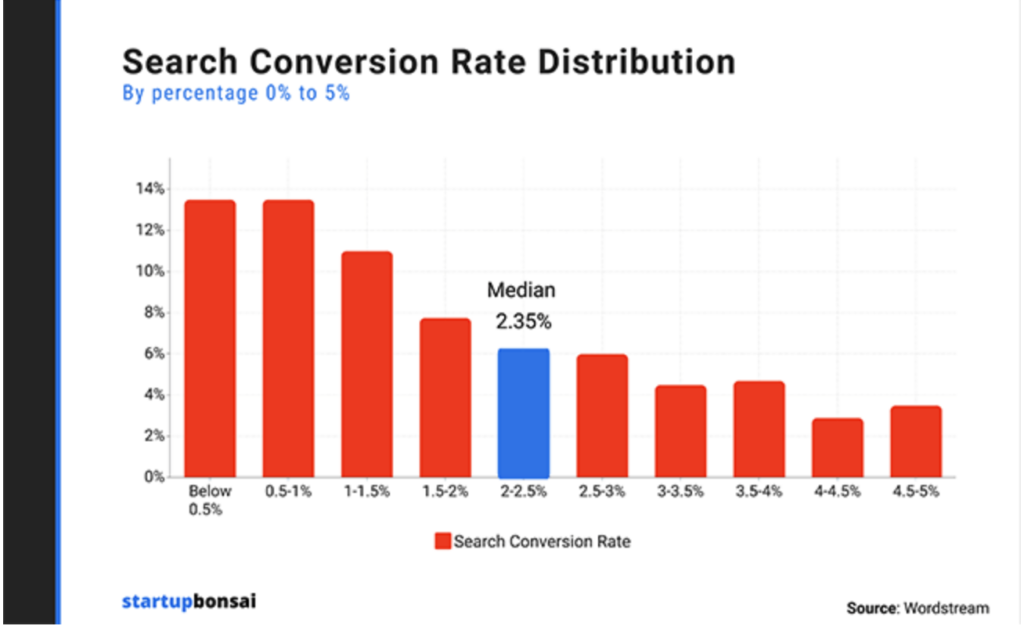You’ve got the website, and you’ve spent considerable time, effort, and money to get your target audience there. But traffic is pointless unless you can get more and more of these visitors to take desirable actions such as filling up a contact form, adding items to cart, or signing up for a newsletter once they are already on your site. How do you do that?
The act of optimizing how many visitors turn into buyers or action-takers is known as conversion rate optimization (CRO). Optimizing conversion rates requires significant thought and action, but there are established best practices that marketers use to guide them in the process.
But Why is CRO so important?
If you were to increase your conversion rate even by a single percentage point, you could end up making a positive difference in your revenue. And the higher the rate of conversions, the more sales come in your door.
In this blog, we take a close look at conversion rate optimization: what it is, why you should be doing it, and how you can get started.
What Is Conversion Rate?
The conversion rate is the percentage of users amongst website visitors who complete a desired action on the site. This desired action can be making a purchase, signing up for a service, contacting your team for more information, or any other goal you’ve set for them.
Tracking your conversion rate over time helps you understand your website’s efficiency in converting visitors to customers. If it’s climbing, you’re doing something right. If it’s slipping, it’s time to figure out why.
How To Calculate Conversion Rate?
Use this formula:
Conversion Rate = (Number of Conversions) / (Number of Visitors) x 100
Here’s breaking down the formula.
Number of Conversions:
This is the total number of visitors who completed the desired action on your site.
Number of Visitors:
This is the total traffic your site received during the same period.
Multiply by 100:
This step is for making the final number a percentage. It helps an easy comparison and understanding.
Let’s say your website recorded 1,000 visitors, and 50 of them made a purchase. Then your conversion rate will be: (50) / (1000) x 100 = 5%
What Is a Good Conversion Rate?
Conversion rates vary across industries, locations, and devices. So, usually, there’s no clear answer for what is a good conversion rate. We can work with the averages in our industry to see if we can bring our website close to it.
In an analysis run by Wordstream, the median conversion rate across a range of accounts was 2.35%. However, the top 25% of best-performing accounts had a conversion rate of 5% or higher.


The average mobile conversion rate is around 1.53% compared to 4.14% on desktop.

Conversion Rate By Device
Source: StartupBonsai
It is usually difficult to answer this question because real conversion data is also hard to source. To obtain accurate conversion rate information, you’d need to be privy to a website’s analytics. While many tools can estimate the number of website visitors, the most accurate data would typically come from a website’s own Google Analytics account.
Here are the many factors that determine your conversion rate:
- Goals: Conversion rates will vary based on the complexity of the action you want them to take. Knowing your end game is crucial.
- Traffic Channel Dynamics: Conversion rates from organic search might differ from those coming in from a social media campaign. Each channel attracts a unique audience with different behaviors.
- Audience Demographics: Age, location, and interests play into how users interact with your site. A conversion rate that works in one demographic might need tweaking for another. For example, if your product’s primary audience is young adults, your conversion rate may differ from a similar product targeting a middle-aged demographic.
In other words, a good conversion rate is dynamic.
It’s best to look at your data and try to improve your conversions. You need to take into account your unique business context and steadily improve from there.
What Is Conversion Rate Optimization?
This is about turbocharging the conversion rate. CRO is a systematic, data-driven method of tweaking your website or landing page based on real user behavior and feedback to increase the percentage of users who perform a desired action on your website.
Imagine you run an online store. Your website might be getting tons of traffic, but if only a handful are buying your products, then CRO is your key action.
You can analyze how users interact with your site, maybe test different button colors, finetune the content, or rework your checkout process. All of this can lead to visitors clicking ‘add to cart’.
Benefits of Optimizing Conversion Rate
Fine-tuning your conversion rates has several benefits.
Better User Experience:
CRO involves removing unnecessary steps and obstacles for the user. This ensures visitors can easily navigate the website, find information effortlessly, and complete desired actions, leading to a more positive and satisfying experience. Optimizing for better user experience also includes creating responsive designs that adapt seamlessly to various devices. This ensures consistent customer satisfaction.
Customer Trust and Loyalty:
When users have a seamless experience consistently and find what they’re looking for, it builds trust. And, trust leads to repeat visits and loyal customers.
Maximized Advertising ROI:
Picture this: You’re spending money on ads to get people to your site. Optimizing your conversion rate ensures that advertising efforts are directed where they are most effective. This positively impacts ad quality scores, potentially reducing advertising costs. Furthermore, CRO allows you to refine your marketing strategies based on real data. This iterative approach ensures that advertising efforts are continually optimized for the best possible performance.
Increased Revenue Flow:
CRO is about strategically targeting the right audience, crafting compelling messaging, and streamlining the user journey. It enhances the likelihood of visitors taking desired actions. This targeted and user-centric approach ultimately drives more conversions. More conversions mean more sales and more sales mean a healthier bottom line.
Data-Driven Decision Making:
Optimizing conversion rates involves meticulously examining quantitative and qualitative data. It provides insights into user behavior, preferences, and interactions with your website. It identifies the current status of your website’s performance and directs you toward the most effective strategies for improvement.
Factors Influencing Conversion Rate Optimization
Let’s dissect the critical elements that can make or break your conversion rates.
Website Design and User Experience
A visually appealing mobile responsive website with thoughtful page layouts, readable content, and fast page load time contributes to a good user experience. User-friendly interfaces encourage longer visits and increased interaction. Engaged users are more likely to explore products, services, or information. When users can easily find what they need, they are less likely to leave the site without taking the desired action.
Content Quality and Relevance
Persuasive copy tailored to the audience’s requirements goes beyond sharing information. It keeps users engaged and guides them toward the specific action for conversion.
Clear Call-to-Actions
Clear Call-to-Actions (CTAs) are signs that tell users exactly what to do.
Additionally, the strategic placement of CTAs is key. Positioning them prominently where users can easily see them prompts immediate attention.
Visual appeal is equally important. A well-designed CTA with contrasting colors or bold fonts draws attention, making it more likely for users to engage.
Moreover, incorporating a sense of urgency or scarcity in CTAs, such as “Limited Time Offer” or “Only a Few Left,” adds a persuasive element that encourages prompt action.
Trust Indicators
These include customer reviews, security badges, and transparent privacy policies. They positively influence the decision-making process, leading to increased conversion rates.
Genuine customer reviews help build credibility and influence potential customers.
Security badges, especially during the checkout process, signal to users that their transactions are secure, reducing concerns about data breaches and encouraging conversions.
Clear and easily understandable privacy policies demonstrate transparency in how customer data is handled. This also communicates a commitment to prioritizing their privacy and security.
A/B Testing
This method helps improve your website by comparing different versions to see which one performs better.
For example, you might test different headlines, colors, or button placements to understand what resonates most with your audience. The version that performs better provides valuable insights into what your visitors prefer and respond to.
A/B testing is an ongoing process of refinement. It allows you to make data-driven decisions to optimize your website, ultimately increasing the likelihood of successful conversions.
Optimal Forms
Website forms are those where visitors input information or complete an action, such as signing up or making a purchase.
When forms are well-designed and easy to fill out, more people will likely complete them. It’s about creating a hassle-free experience, like offering a simple and quick route for visitors to achieve their goals on your website. Ultimately, optimal forms contribute to a positive user experience, making it more likely for visitors to follow through and boost your success rates.
Personalization
This strategy involves tailoring your website’s content and offerings to suit the preferences and interests of each visitor.
For example, if a visitor has previously looked at certain products or categories, a personalized website might highlight similar items or provide recommendations based on their preferences. This targeted approach captures the visitor’s attention because it feels more relevant to their needs.
Personalization creates a more engaging and individualized experience. This increased engagement boosts the chances of users taking desired actions.
Key Takeaways
Think of CRO as a critical ingredient to maximize your website’s potential. It’s like turning visitors into customers and consequently brand loyalists. This metric hinges on understanding and catering to the needs and preferences of your customers.
Picture your website as a store. CRO is like arranging the shelves, making sure things are easy to find, and the checkout is smooth. It’s not just about getting more people to buy. It’s about making sure everyone who visits the store has a great experience and comes back.
This process is ongoing. Keep an eye on how people are using your site, adjust elements as needed, and stay in the loop about what’s happening in your industry.
This dynamic approach ensures that your website doesn’t just keep pace; it leads the way. With CRO, you can create a lasting impact on your audience and solidify your digital success.
FAQs
How often should I update my website for optimal Conversion Rate Optimization?
While there’s no fixed timeline, regularly monitor user behavior, and industry trends, and test different elements to enhance your website’s performance. A proactive approach ensures ongoing improvement.
Can Conversion Rate Optimization benefit businesses beyond e-commerce?
Yes! CRO is important for every online business model. Whether you’re focused on lead generation, subscriptions, or any other desired action, optimizing conversion rates ensures a positive user experience and improved business growth.
Can Conversion Rate Optimization benefit small businesses with limited online traffic?
CRO is valuable for businesses of all sizes. Even with limited traffic, optimizing your website ensures that the visitors you have are more likely to convert, maximizing the impact of every interaction.
What role does user feedback play in Conversion Rate Optimization?
User feedback is crucial. Actively seek and analyze feedback to understand user preferences, pain points, and expectations. Incorporating this information into your optimization efforts helps create a more user-centric and effective website.
Are there common mistakes to avoid in Conversion Rate Optimization?
Yes. Some common mistakes include making changes without data-driven insights, neglecting mobile responsiveness, having unclear call-to-actions, and not regularly testing different elements. Learning from these common pitfalls can enhance the effectiveness of your Conversion Rate Optimization strategy.










